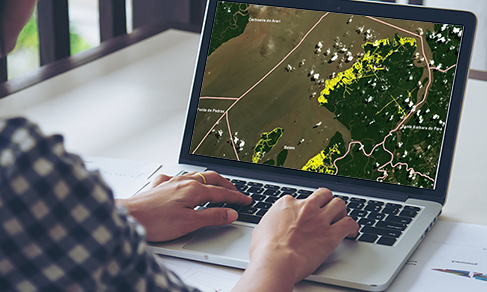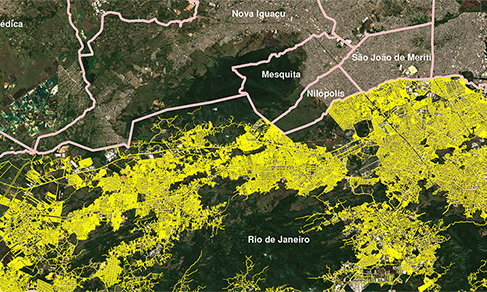Nossos serviços estão apresentando instabilidade no momento. Algumas informações podem não estar disponíveis.
Block-Face Database for Brazilian Addresses
Description
It is a geospatial database of lines that graphically represent the streets of urban areas, urban extension and rural agglomerations of Brazilian municipalities. In addition to the graphic information, there are attributes that refer to the name of the addresses, the territorial structure and the National Address List for Statistical Purposes – CNEFE. The Block-Face Database is fully updated at each Population Census and, between Censuses, it undergoes a continuous and cumulative process of specific updates in accordance with the progress of the institute's surveys and in accordance with specific field campaign actions carried out by teams from the Collection Network in the Agencies of the State Branches of the IBGE. In the current version, it reaches 13,688,342 line segments corresponding to block-faces, represented as a fundamental source for portraying the Brazilian territory and reflecting on its dynamics, supporting decision-making and the implementation of public policies with greater efficiency.
It is used by the IBGE to plan and carry out Census data surveys and Statistical Surveys such as the Continuous National Household Sample Survey - Continuous PNAD and the Consumer Expenditure Survey - POF, among others, covering all Brazilian municipalities, especially their cities and villages.
The construction of this database began with the migration of data from the 2007 Census (Census of Agriculture and Population Count), plus vector data through agreements with city halls and/or hiring of private companies, 2010 Population Census, 2017 Census of Agriculture and specific updates based on field surveys for the National Household Sample Survey, unifying the mapping used in these operations. These data were originally produced from different data sources, including cadastral mapping at different reference scales that have been adjusted, as available, to the geometries of high spatial resolution images, constituting precious elements in combination with the Mesh of Enumeration Areas.
About the publication - 2022 - Preliminary Results
This product brings the georeferenced graphical representation of the block-faces of addresses to which data from the National Address Files for Statistical Purposes (CNEFE) are associated, representing the georeferenced location of the addresses visited by enumerators in urbanized areas and in rural settlements during the collection of the 2022 Population Census 2022, in accordance with the addressing standard adopted by the IBGE.
This version partially incorporates updates from census collection, reflecting the current stage of data processing and review by the IBGE. During the census operation, the Supervisory Census Agents made corrections or additions to the maps, which were recorded digitally and stored in the form of sequences of geographic coordinates obtained by a GNSS sensor. After collection, the gathered data were subjected to analysis for improvement until this version was released.
This version of the product brings together the block-faces confirmed by supervisors in the field and duly associated with data from the National Address Files for Statistical Purposes updated during the collection of the 2022 Population Census. The block-faces included by supervisors in the field through the tracking procedure are being consolidated and are expected to be available in the next version of the product.
The updated Block-Face Database for the 2022 Population Census collection reached 13,854,931 line segments corresponding to street block-faces, which represents a positive change of 31% compared to the 2010 Population Census.
More on the product - 2022 - Preliminary Results
Database
- Block-Face Database of Addresses by FU/Municipalities (shp)
- Block-Face Database of Addresses by FU/Municipalities (json)
Application
- Block-Face Database of Addresses (Interactive Geographic Platform)
- Geographic Framework of Reference for Statistical Production, Analysis and Dissemination (Interactive Geographic Platform)
Learn more - 2022 - Preliminary Results
Quantitativos
- 5568 Municípios;
- 1 Distrito Federal (Brasília – DF);
- 1 Distrito Estadual (Fernando de Noronha – PE);
Arquivos – Formatos e atributos
A Base de Faces de Logradouros 2022 está estruturada por Municípios, em arquivos vetoriais no formato shapefile (SHP), compatíveis com utilização em diversos Sistemas de Informação Geográfica – SIG, organizados em pastas contendo para cada um os seguintes campos de atributos:
| Campo | Tipo | Tamanho | Descrição |
|---|---|---|---|
| CD_SETOR | C | 16 | Geocódigo do Setor da Malha de Setores Censitários Preliminares |
| CD_QUADRA | C | 3 | Código da Quadra |
| CD_FACE | C | 3 | Código da Face |
| NM_TIP_LOG | C | 20 | Tipo do segmento do Logradouro: "Rua", "Avenida", "Travessa" etc. |
| NM_TIT_LOG | C | 30 | Título do segmento do Logradouro: "Almirante", "Presidente" etc. |
| NM_LOG | C | 60 | Nome do segmento do Logradouro |
| TOT_RES | N | 3 | Total de espécie residencial |
| TOT_GERAL | N | 3 | Total de espécies |
Referências Geodésicas e Cartográficas
Esta versão da Base de Faces de Logradouros observa a divisão político-administrativa vigente na data de referência do Censo Demográfico, isto é, a noite de 31 de julho para 1º de agosto de 2022 e, portanto, considera os limites atualizados e comunicados ao IBGE pelos Órgãos Estaduais competentes entre 01/05/2021 e 31/07/2022. Contou-se ainda com prazo diferenciado para fins de incorporação nos resultados definitivos do Censo Demográfico 2022, de acordo com a Resolução do Conselho Diretor R.CD-IBGE nº 32/2022 de 09 de junho de 2022.
A Base de Faces de Logradouros utiliza como referência geodésica e cartográfica o Sistema Geográfico não projetado ou Sistema de Coordenadas Lat. / Long. com codificação de texto UTF 8. Este sistema, por não ser uma projeção cartográfica, não tem parâmetros, mas apenas a definição do sistema geodésico de referência.
Com relação ao sistema geodésico de referência, o Datum Horizontal utilizado é SIRGAS – Sistema de Referência Geocêntrico para as Américas (SIRGAS), em sua realização do ano de 2000 (SIRGAS2000), conforme Resolução da Presidência do IBGE Nº 1/2005, disponível em https://www.ibge.gov.br/geociencias/informacoes-sobre-posicionamento-geodesico/sirgas/16691-projeto-mudanca-do-referencial-geodesico-pmrg.htm ? edicao=16692&t=resolucoes-e-legislacao.
Destaque quanto à Qualidade, Uso e Escalas
A Base de Faces de Logradouros é produzida em escala cadastral e com compatibilidade aos insumos adotados na geração progressiva da sua construção, e, parcialmente às atualizações capturadas pelas atividades de coletado Censo Demográfico 2022. Apesar das linhas de Faces terem sido georreferenciadas utilizando imagens disponíveis, pode haver discrepâncias posicionais em relação ao mundo real em algumas áreas do território em função da indisponibilidade de imagens mais recentes em pontos mais remotos do país e da não incorporação completa, nesta versão, dos dados provenientes da coleta censitária.
Nesse sentido, alertamos que alguns dados gerados, podem ocasionalmente, apresentar imperfeições nas condições geométricas, no georreferenciamento e nas regras topológicas, tais como faces com extensões e azimutes incoerentes e sem contiguidade, faces sem conectividade e com ausência de nós.
Os atributos que compõem a Base de Faces de Logradouros podem, ocasionalmente, apresentar incoerências no seu conteúdo, como nomes diferentes para trechos de faces de um mesmo logradouro, nomes desatualizados ou mesmo falta de nomes, em função de alguma inviabilidade em realizar o vínculo entre o nome do logradouro e a face vetorizada.
Os logradouros foram atualizados abrangendo tanto as áreas urbanas quanto as áreas rurais, inclusive as Favelas e Comunidades Urbanas, povoados, lugarejos e núcleos, bem como, áreas de expansão urbana e de difícil acesso, onde o registro de endereços tende a ser frágil e não formalizado.
Este produto reproduz as limitações do contexto de sua produção, isto é, a atualização com finalidade de viabilizar os levantamentos estatísticos. O IBGE não se responsabiliza pela correção de eventuais imperfeições e nem de outras porventura existentes. Ao utilizar esta base de dados, o usuário deve estar ciente dessas limitações.
Com esta divulgação, espera-se estimular a atualização de cadastros e registros, permitindo não só a realização de comparações, como também eventuais correções e possíveis incorporações de dados de outras fontes. O IBGE agradece a comunicação de eventuais equívocos e estimula o aprofundamento de parcerias que permitam dispor de dados geoespaciais mais consistentes e precisos.
News and Releases
Block-Face Database grows 31% from 2010 to 2021
The IBGE launches today (Dec 15) the 2021 Block-Face Database in digital format. The product consists...
15/12/2022
Block-face Database for Public Areas increases 29% between 2010 and 2020
The IBGE publishes today (13) the Block-face Database for Public Areas 2020, which encompasses urban...
13/07/2021
Errata
Calendar error in release "2022 Population Census: Block-Face Database for Brazilian Addresses"
Published date: 12/04/2024
Description
Error characterized for not meeting the release date of the product, according to calendar released in December 2023. The product was delayed due to the need to reprocess the lines representing the block faces, due to inconsistencies found in the consolidation of the basic inputs.Therefore, the release of the 2022 version of the product Block-Face Database for Brazilian Addresses, was postponed from April to June 2024.
Actions: The release calendar has been changed.





